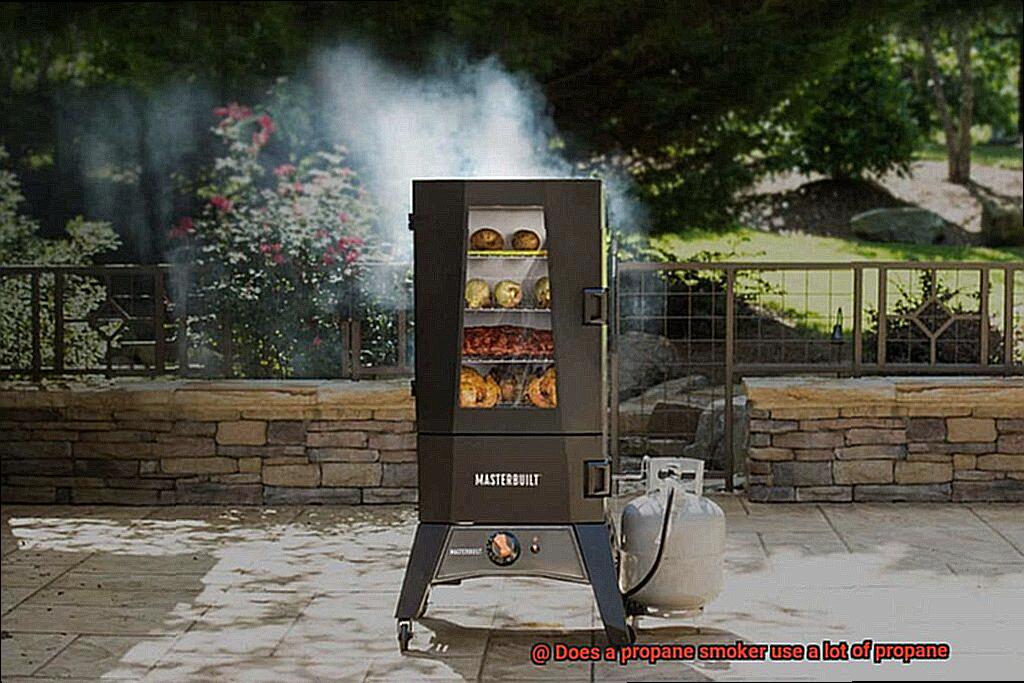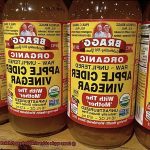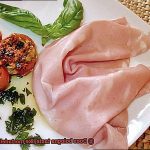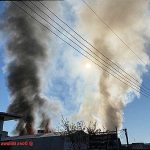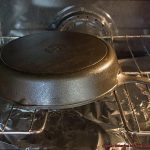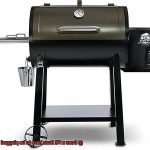If you’re like me and can’t resist the tantalizing taste of perfectly smoked meat, then you’ve probably thought about getting yourself a propane smoker. But here’s the burning question: does this bad boy consume propane like it’s going out of style?
Well, fear not. Today, we’re diving into the juicy details of how much propane these babies usually go through.
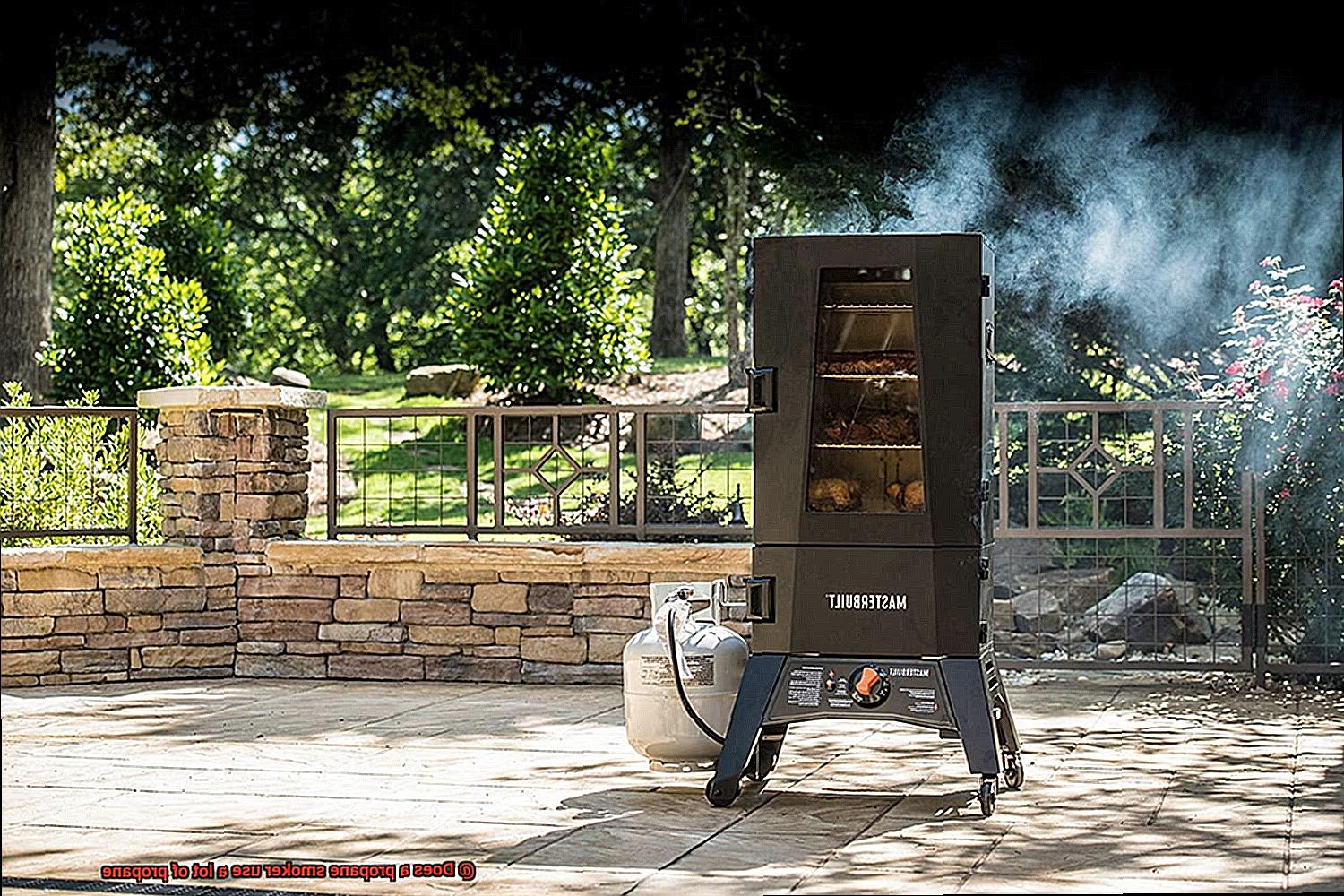
So grab a cold one, kick back, and let’s become masters of the propane-smoking game together.
Contents
What is a Propane Smoker?
With its unique design and features, a propane smoker provides convenience, temperature control, versatility, and fuel efficiency.
First and foremost, the construction of a propane smoker is well-thought-out. It typically consists of a sturdy metal cabinet or box with a door that ensures optimal heat retention. Adjustable racks are provided to accommodate different types and sizes of food, allowing for simultaneous smoking of various dishes. A water pan is included to add moisture and enhance the tenderness of the food.
The heart of the propane smoker lies in its heating element, which is fueled by propane gas. This heating element is connected to a propane tank via a hose and regulator, giving users full control over the temperature inside the smoker.
The convenience that a propane smoker offers is unparalleled. Unlike traditional charcoal or wood smokers that require constant monitoring and tending to a fire, propane smokers provide a consistent heat source with minimal effort. With just a simple turn of the knob, users can easily adjust and maintain their desired cooking temperature. No more worrying about fluctuating temperatures or adding more fuel to keep the fire going.
Temperature control is key when it comes to smoking food, and propane smokers excel in this aspect. Equipped with adjustable burners, these smokers allow users to regulate flame intensity and temperature accurately.
Many models even come with built-in thermometers and adjustable vents, ensuring precise temperature management throughout the cooking process. This level of control guarantees perfectly smoked dishes every time.
Versatility is another standout feature of propane smokers. Multiple cooking racks provide ample space for smoking different types of food simultaneously, making it ideal for large gatherings or when variety is desired. Some propane smokers go above and beyond by offering additional options such as side burners or grills, expanding the cooking techniques that can be accomplished with this versatile appliance.
In addition to its convenience and versatility, a propane smoker is also fuel-efficient. The adjustable burners allow users to match the propane flow to their cooking needs, minimizing fuel wastage. Modern propane smokers are designed with insulation features that help retain heat, reducing overall propane consumption. To optimize fuel usage, it is recommended to preheat the smoker before adding food and minimize opening the door frequently during cooking. Regular maintenance and proper cleaning of the smoker also contribute to efficient fuel usage.
Factors Affecting Propane Consumption
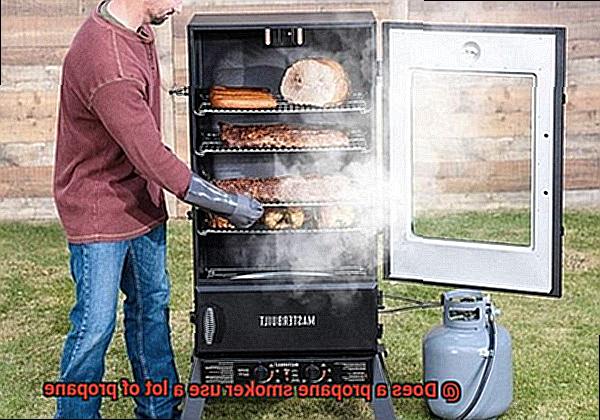
There are several factors that can significantly impact propane consumption when using a smoker for grilling. These factors include the size and type of the propane smoker, temperature settings, duration of use, outdoor conditions, insulation and seals, maintenance and cleanliness, cooking style and recipes, and personal preferences.
The size and type of the propane smoker can have a direct effect on propane consumption. Larger smokers generally require more fuel compared to smaller ones. Additionally, different types of smokers may have variations in their propane usage. For example, vertical smokers may consume propane differently than offset smokers.
Temperature settings play a crucial role in determining propane consumption. Higher temperatures require more fuel to maintain the desired heat level. So, if you’re aiming for a sear on a steak at a high temperature, it will naturally require more propane compared to smoking at a lower temperature for a prolonged period.
The duration of use is another important factor. Longer cooking sessions naturally require more fuel compared to shorter ones. For instance, smoking a brisket for 12 hours will use more propane compared to smoking chicken wings for just an hour.
Outdoor conditions such as ambient temperature and wind can also affect propane consumption. Colder weather conditions or windy environments may cause the smoker to work harder to maintain the desired temperature, resulting in increased fuel usage.
The quality of insulation and seals in the smoker can impact propane consumption as well. Well-insulated smokers with tight seals will be more efficient at retaining heat, reducing the need for additional fuel.
Regular maintenance and cleanliness of the smoker are crucial for optimal performance and fuel efficiency. A dirty or poorly maintained smoker may require more propane to achieve and maintain the desired temperature.
Different cooking styles and recipes can also influence propane consumption. Some recipes may necessitate longer cooking durations or higher temperatures, leading to increased propane usage.
Finally, personal preferences can play a role in propane consumption. Some individuals may prefer to cook at higher temperatures or extend their cooking times, resulting in higher fuel consumption.
Size of the Smoker
The size of a smoker can greatly affect its propane usage, making it an important consideration for those looking to optimize fuel efficiency. Smokers come in a range of sizes, from small portable models to large commercial-grade ones, each with its own benefits and propane consumption rates.
Smaller smokers, such as tabletop or portable ones, are designed for individuals or small families with modest cooking needs. These compact smokers typically have smaller propane tanks and consume less fuel compared to their larger counterparts. They offer a convenient and efficient solution for enjoying grilled meals without excessive propane usage.
Medium-sized smokers strike a balance between cooking capacity and fuel efficiency, making them popular choices for average-sized families or small gatherings. While they may require slightly more propane than smaller smokers, their consumption rates remain reasonable and can easily satisfy most grilling needs.
On the other end of the spectrum, large smokers are often used by professional caterers or for big events. These robust smokers have larger cooking surfaces and higher heat output requirements, resulting in higher propane consumption. If you frequently host large gatherings or need to cater to a large number of people, be prepared for the increased fuel usage associated with these larger smokers.
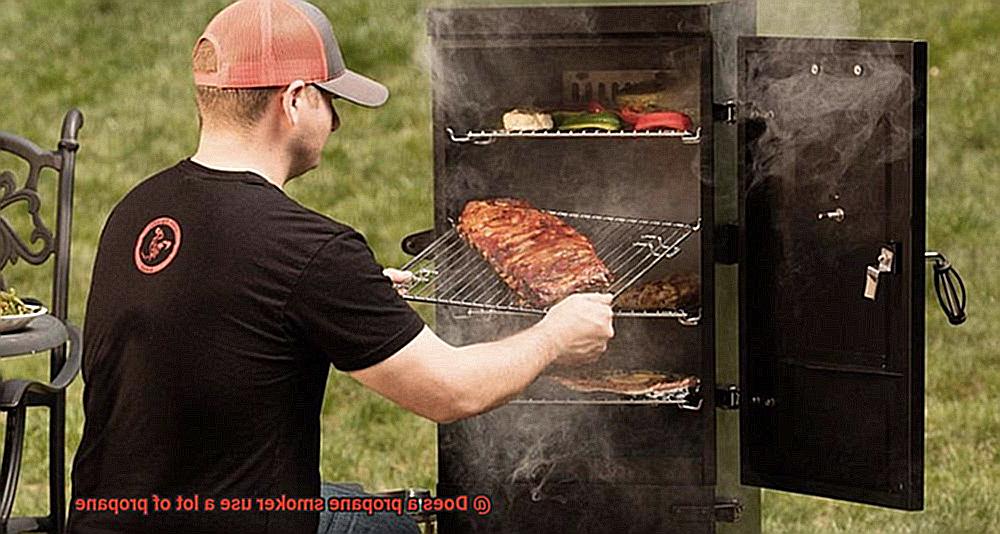
However, it’s important to note that the size of the smoker is not the sole determinant of propane usage. Other factors such as insulation, temperature control, and cooking techniques also play significant roles. Smokers with excellent insulation can retain heat more efficiently, reducing propane consumption. Additionally, smokers equipped with precise temperature control features allow users to maintain a consistent temperature without wasting excess fuel.
Furthermore, the type of food being cooked also affects propane usage. Smoking larger cuts of meat that require longer cooking times naturally consumes more fuel compared to smoking smaller cuts or vegetables. By considering these factors in addition to the size of the smoker, individuals can make informed decisions about their propane usage and ensure efficient grilling experiences.
Temperature Control
Propane smokers, with their superior temperature control, reign supreme over other types of smokers like charcoal or electric smokers. This control is made possible by the propane burner, which not only heats up the smoker but also allows for precise adjustments. Unlike its counterparts, the propane smoker boasts a temperature control dial or knob that makes it a breeze for users to set and maintain their desired temperature.
The temperature range of a propane smoker varies depending on the model, but most can reach scorching temperatures between 200°F and 400°F. This impressive range grants users the freedom to cook a wide assortment of foods, from succulent slow-smoked brisket to mouthwatering quickly seared steaks.
One of the many perks of using a propane smoker is its rapid heating capabilities and ability to maintain a steady temperature throughout the cooking process. Achieving consistent and evenly cooked results is paramount, and the propane smoker delivers on this front. Its versatile burner can be adjusted to provide high heat for those delectable searing moments or low heat for leisurely slow smoking sessions, giving users endless possibilities in their culinary adventures.
However, external factors like weather conditions can still influence the overall performance of a propane smoker. In chilly climates or blustery environments, more propane may be necessary to maintain that desired temperature.
Thankfully, with proper insulation and precautions such as windbreaks, users can significantly minimize the impact of these external factors on their precious propane consumption.
To ensure a seamless cooking experience, several factors come into play when it comes to propane usage: the size and insulation of the smoker, ambient temperatures, cooking duration, and personal cooking preferences. While propane smokers are generally efficient in fuel consumption, it’s always wise to have an extra propane tank on hand for those lengthier cooking sessions or unexpected surprises.
Duration of Cooking
The duration of cooking in a propane smoker is a fascinating topic that involves various factors, each playing a crucial role in achieving the perfect smoked delicacies. From the type of food and temperature setting to the size of the smoker and weather conditions, all these elements contribute to determining the cooking time.
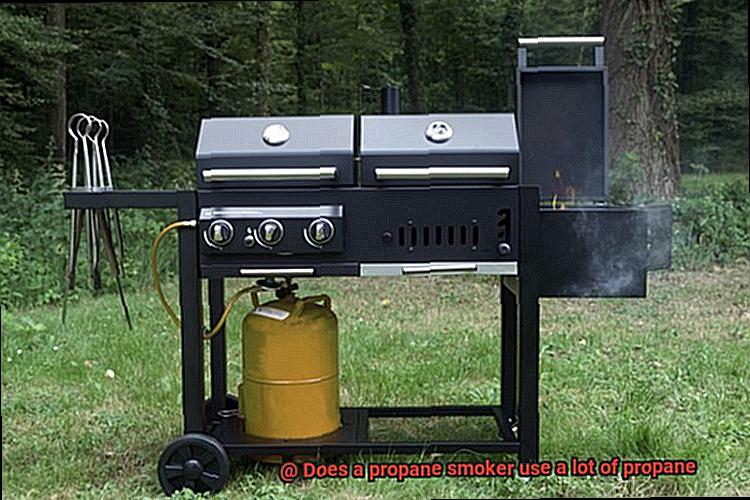
Different types of food require different cooking times. Meats like brisket or ribs demand several hours of slow cooking to achieve that mouthwatering tenderness and juiciness. Conversely, vegetables or fish can be prepared relatively quickly, allowing for a faster cooking process.
Propane smokers come with adjustable temperature controls, granting users the freedom to set their desired cooking temperature. The higher the temperature, the faster the food will cook. However, it is essential to find the right balance, as excessively high temperatures may result in overcooked or burnt food.
The size of the smoker also plays a vital role in determining the cooking duration. Larger smokers need more time to reach and maintain the desired temperature, while smaller ones heat up swiftly. Considering the size of the smoker is crucial when planning your cooking time, ensuring efficient heat distribution and proper cooking.
Furthermore, the amount of food being cooked directly impacts the cooking duration. Preparing a large quantity of food will inevitably require more time compared to a smaller portion. It is crucial to allocate enough space in the smoker for even heat distribution and ensure that each piece cooks perfectly.
External factors such as weather conditions can also affect the cooking duration. Colder temperatures or windy conditions may prolong cooking times due to their impact on heat retention in the smoker. Therefore, during adverse weather conditions, it is crucial to make necessary adjustments and closely monitor the temperature for optimal results.
To optimize cooking duration and reduce potential propane wastage, it is recommended to preheat the smoker before adding food and avoid frequently opening it during the cooking process. Opening the smoker causes heat loss and increases cooking time.
Optimizing Propane Usage
Optimizing propane usage when grilling on a propane smoker involves several key strategies. By implementing these strategies, grill enthusiasts can minimize propane consumption while still enjoying flavorful and perfectly cooked meals. Here are the sub-topics and lists to help you optimize propane usage:
Proper Preheating:
- To reduce overall cooking time and propane consumption, it is important to preheat the smoker properly.
- Start by turning on the propane tank and igniting the burner.
- Close the smoker’s lid and let it preheat for 10-15 minutes until it reaches the desired temperature.
Consistent Temperature:
- Maintaining a consistent temperature throughout the cooking process is vital to optimize propane usage.
- Use a built-in thermometer or a separate probe thermometer to monitor the temperature closely.
- Make any necessary adjustments to the burner control to maintain a steady heat source.
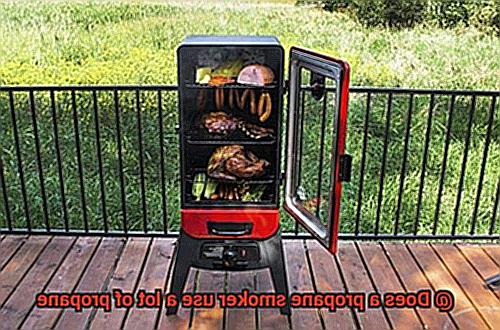
Right Amount of Propane:
- Using the appropriate amount of propane for the size of your smoker is crucial.
- Overfilling the propane tank can lead to unnecessary waste, while underfilling may cause interruptions during cooking.
- Follow the manufacturer’s guidelines for propane tank size and refill accordingly.
Insulation:
- Insulating the smoker helps retain heat inside, reducing the need for excess propane to maintain temperature.
- Enhance insulation by adding materials such as foil or blankets to the exterior of the smoker.
- Ensure proper airflow is maintained to prevent overheating.
Propane-Specific Smoker:
- Opt for a smoker specifically designed for propane to maximize propane efficiency.
- Propane smokers are engineered with features that enhance heat distribution and retention, resulting in more efficient cooking with minimal propane consumption.
Regular Maintenance:
- Regularly clean and inspect the burner, valves, and other components of your smoker.
- This ensures proper functionality and prevents gas leaks or inefficiencies that can lead to increased propane consumption.
- Don’t forget to clean out ashes and debris from previous cookings, as they can affect airflow and heat distribution.
Preheating the Smoker
Preheating the smoker is an essential step in the smoking process. It’s like warming up before a workout – it ensures that your smoker is ready to deliver optimal performance and that your food will be smoked to perfection. Here’s why preheating is so important:
- Achieving and Maintaining Temperature: Preheating ensures that your smoker reaches the desired temperature and stays there throughout the cooking process. This is crucial for producing evenly cooked, flavorful food.
- Propane Usage Factors: The size and model of your smoker, outdoor temperature, and desired cooking temperature all impact propane usage during preheating. Larger smokers require more propane to heat up their larger cooking chambers, while colder temperatures may prolong the preheating time and increase propane consumption.
- Propane Efficiency Tips: To minimize propane usage during preheating, start with a higher initial temperature setting and then lower it once the desired temperature is reached. Proper insulation and sealing of your smoker can also help conserve propane by preventing heat loss.
- Beyond Preheating: Optimizing propane usage in a propane smoker involves other factors too. Controlling airflow, maintaining a consistent cooking temperature, and using the right amount of propane for your smoker’s size are all important considerations.
- Efficient and Cost-Effective: While a propane smoker consumes propane during preheating and cooking, it is generally considered an efficient and cost-effective method compared to charcoal or wood smokers.
Maintenance and Cleaning
Maintaining and cleaning your propane smoker is crucial for ensuring its optimal performance and longevity. Regular cleaning removes grease, food residue, and debris that can affect the flavor of your food. In this article, we will guide you through the step-by-step process of properly maintaining and cleaning your propane smoker.
Safety First:
When it comes to maintenance and cleaning, safety should always be a top priority. Before starting any cleaning or maintenance procedures, ensure that the propane tank is disconnected, and the smoker has cooled down completely to avoid accidents or injuries.
Remove Removable Parts:
To clean your propane smoker effectively, start by removing the cooking grates, water pan, and drip tray. These components are easily removable and should be cleaned separately.
Clean the Cooking Grates:
The cooking grates are exposed to high temperatures and food particles during use. Scrub them with a grill brush or sponge to remove any stuck-on food particles. If necessary, soak them in warm soapy water before scrubbing to loosen stubborn residue.
Wipe Down the Interior:
Using a damp cloth or sponge, wipe down the interior surfaces of the smoker, including the walls, ceiling, and floor. This step removes grease, smoke residue, and any dirt that may have accumulated over time. Avoid using abrasive cleaners or steel wool as they can damage the surface.
Pay Attention to the Burner:
The burner and its components are crucial for generating heat and ensuring even cooking. Clean them using a brush or cloth to remove any grease buildup or debris that may affect their performance.
Empty and Clean Water Pan or Drip Tray:
The water pan or drip tray collects excess grease and moisture during cooking. Empty these components and remove any leftover liquid or food particles. Cleaning them regularly helps maintain moisture levels inside the smoker and prevents flare-ups during cooking.
Check Propane Regulator and Hose:
Inspect the propane regulator and hose for any signs of damage or wear. These components are responsible for delivering fuel to the burner. If you notice any issues, such as cracks or leaks, it’s advisable to replace them to ensure safe operation.
Reassemble and Test:
After all the parts are dry, reassemble them properly and securely in place. Before using your propane smoker again, perform a test run to ensure everything is working correctly. This step ensures that your smoker is ready to deliver delicious results.
CvB2jBcz2MM” >
Conclusion
In conclusion, a propane smoker offers convenience, precise temperature control, incredible versatility, and impressive fuel efficiency. These smokers are built with sturdy construction, adjustable racks, and a water pan that enhances heat retention and moisture.
The magic behind a propane smoker lies in its ability to harness the power of propane gas. With just a simple flick of a switch, you can ignite a consistent flame that provides steady heat throughout your cooking journey. It’s like having your own personal fire-breathing dragon at your command.
Temperature control is where the propane smoker truly shines. You have complete control over the intensity of the flame, allowing you to maintain precise temperatures for hours on end. Whether you’re slow-smoking some succulent ribs or searing a mouthwatering steak, the propane smoker has got your back.
But it doesn’t stop there – this culinary beast also offers remarkable versatility. With multiple cooking racks at your disposal, you can smoke different types of food simultaneously. Imagine filling your backyard with the tantalizing aroma of smoked sausages, juicy chicken wings, and tender brisket all at once. Your taste buds won’t know what hit them.
Now let’s talk about fuel efficiency. Propane smokers are designed to be efficient propane-guzzling machines (in the best way possible). While factors such as size, temperature settings, duration of use, outdoor conditions, and personal preferences can affect propane usage, there are ways to optimize it.
Picture this: you preheat your smoker to perfection before loading it up with delicious meats and veggies. By doing so, you maximize performance while taking into account factors like size and desired cooking temperatures. It’s like giving your smoker a warm-up routine before it gets down to business.
And don’t forget about regular maintenance. Cleaning removable parts like grates and pans ensures that no greasy residue interferes with flavor perfection. Checking burner components and inspecting regulators and hoses keeps everything running smoothly and safely.
So, does a propane smoker use a lot of propane? Well, it certainly uses some, but when compared to charcoal or wood smokers, it’s an efficient and cost-effective option. By following the fuel efficiency and maintenance tips outlined in this article, you can savor mouthwatering smoked meals while minimizing your propane usage.

